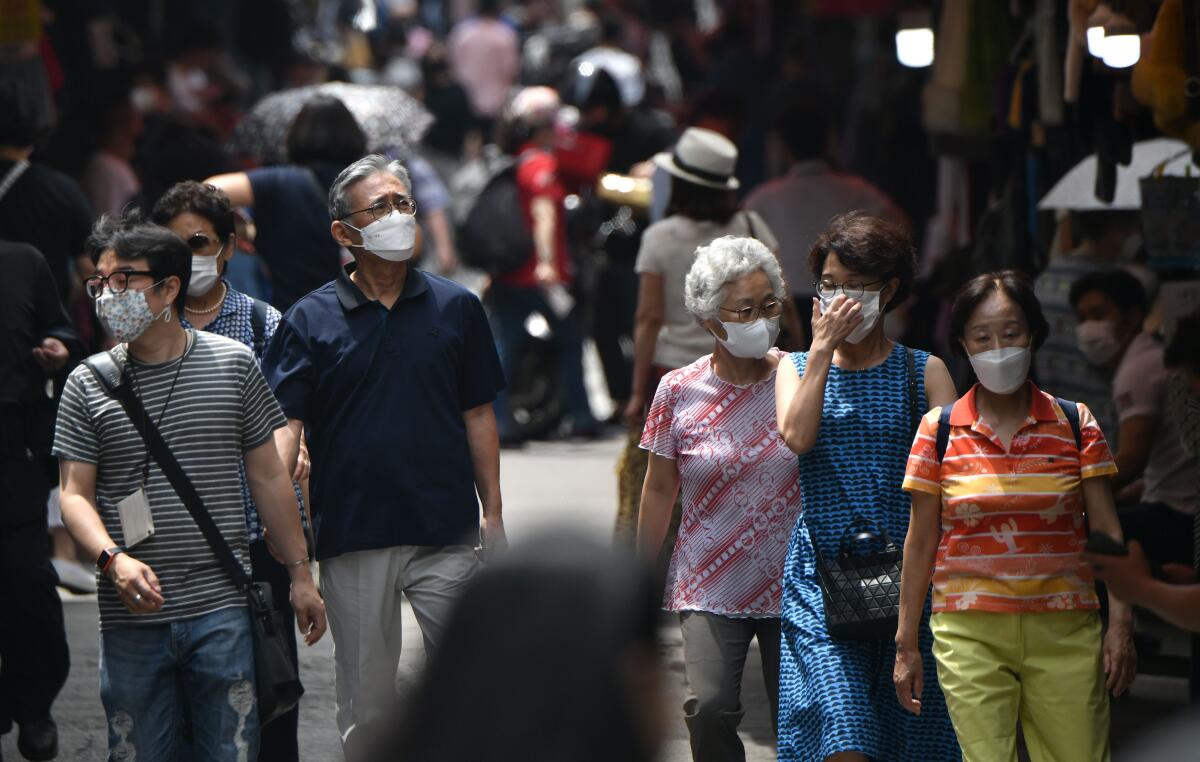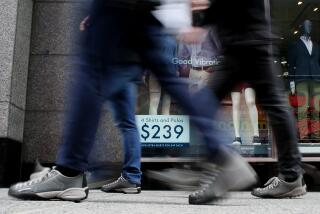‘The crisis is far from over.’ World economy faces an uphill climb

- Share via
The world economy is entering the second half of 2020 still deeply weighed down by the COVID-19 pandemic, with a full recovery now ruled out for this year and even a 2021 comeback dependent on a lot going right.
It’s a scenario few if any predicted at the start of the year when most economists were banking on another year of expansion and a U.S.-China trade agreement was meant to give corporate and investor confidence a shot in the arm.
Instead, the pandemic forced swathes of the global population into what the International Monetary Fund dubs “The Great Lockdown.” Central banks and governments responded with trillions of dollars in unprecedented support to prevent markets from melting down and to keep furloughed workers and struggling companies afloat until the virus passed.
Even with those rescue efforts, the world is still suffering its worst economic crisis since the Great Depression. While some gauges of manufacturing and retail sales in major economies are showing improvement, hopes for a V-shaped rebound have been shattered as the reopening of businesses looks shaky at best and job losses risk turning from temporary to permanent.
It’s an economic trajectory Federal Reserve Bank of Richmond President Thomas Barkin has likened to riding the elevator down but needing to take the stairs back up.
“There is a real danger of confusing rebound with recovery,” Carmen Reinhart, the World Bank’s chief economist, said at the Bloomberg Invest Global conference on June 23. “True recovery means you are at least as well off as you were before the crisis started, and I think we are a long way off that.”
Uncertain times
Much depends on the spread of the coronavirus, a vaccine for which remains out of grasp. The World Health Organization warns that the worst of the pandemic is still to come as cases top 10 million and deaths have risen beyond 500,000. And even in countries where the virus appeared contained, fresh flare-ups are frequent.
The IMF estimates that by the end of this year 170 countries — or almost 90% of the world — will have lower per capita income. That’s a reversal from January, when it predicted 160 countries would end the year with bigger economies and positive per capita income growth.
It’s now likely that global gross domestic product by the end of 2021 will in many cases still be lower than where it was at the end of 2019, according to HSBC Holdings economists led by Janet Henry. Bloomberg Economics describes it as “Goodbye Victory V, Hello Worry W.”
Central bankers remain on the alert to do more. Federal Reserve Chairman Jerome H. Powell has warned that the outlook is “extraordinarily uncertain” and European Central Bank President Christine Lagarde has spoken of a “restrained” recovery that will change parts of the economy permanently.
To be sure, there are pockets of recovery that could gain traction. Morgan Stanley economists are sticking to forecasts of a V-shaped recovery, pointing to positive surprises in recent economic data, especially in the U.S. and euro region.
Global markets are split between investors betting on a V-shape recovery and those expecting significant dislocations. The MSCI All-Country World Index of global stocks has gained nearly 40% from a March low but is still down about 6% this year as investors bet policy stimulus around the world will cushion the economic impact from the pandemic. U.S. 10-year Treasury yields have tumbled by more than 100 basis points this year to around 0.67%.
Mixed performance
Lessons on how the recovery plays out are being drawn from Asia, where the virus has been brought under control but the rebound has been mixed.
In South Korea, which flattened its infection curve months ago, the emergence of new virus clusters is casting a chill on shoppers.
China’s manufacturing activity climbed in June, as did other manufacturing gauges across the region, yet new orders continue to show weakness.
That worrisome outlook means businesses are navigating in the dark, according to Joerg Wuttke, president of the EU Chamber of Commerce in China, who expects the uncertainty to last for another couple of years.
‘Chainsaw’ recovery
“The recovery is not V, it is not W, it is looking like the top of a chainsaw,” he said. “Up and down and up and down and painful all the way.”
It also means that fast-expanding emerging economies won’t be the global growth engine they have been, with the World Bank predicting this group of countries will shrink 2.5% — their worst performance in data that starts in 1960. Latin America is now on the front lines of the virus.
A complete rebound to pre-crisis levels looks impossible until the virus is controlled — an outlook that’s especially true for sectors such as tourism, transport and entertainment where restrictions are expected to linger.
The hit to labor markets has been worse than initially estimated and will be impossible to repair in the second half of 2020 even under the most optimistic scenario, according to the International Labour Organization. It last week estimated that working hours in the second quarter were 14% lower than before the virus, equivalent to a loss of 400 million full-time positions.
Although U.S. companies added 4.8 million people to payrolls in June, only three in 10 jobs lost have been recovered and initial applications for unemployment benefits remain elevated. More than 2.8 million Americans lost their jobs for good in June.
Debt worries
“While a near-term mechanical bounce in economic activity in response to the easing of lockdown measures looks likely, we expect the subsequent climb to be long and arduous,” said Joachim Fels, global economic advisor at Pacific Investment Management Co.
There are other challenges too.
Record levels of debt will restrain how much additional support governments can roll out — on top of the $11-trillion fiscal stimulus already in train.
Governments are grappling with how to extend or terminate costly near-term measures to fund wages and keep companies alive, while at the same time gearing up for longer-term stimulus to drive a recovery.
That borrowing won’t come without side effects, such as keeping zombie companies going, according to Alicia Garcia Herrero, chief Asia Pacific economist with Natixis.
“If there is no cleanup of debt, going back to pre-crisis levels will take even longer,” said Garcia Herrero.
Meanwhile, central banks have slashed interest rates to new lows, with some embracing negative borrowing costs. In a bid to cap market rates, multiple types of assets have been bought and policymakers continue to tweak their tool kit with hints of more innovation to come.
Morgan Stanley predicts $13 trillion in cumulative central bank balance-sheet expansion from the U.S., euro region, Japan and U.K. through the end of 2021.
Even with those steps, it’s too soon to conclude they will be enough, said Kazuo Momma, who used to be in charge of monetary policy at the Bank of Japan.
“The crisis is far from over,” he said.
--With assistance from Bloomberg writers Zoe Schneeweiss, Lianting Tu and Tan Hwee Ann.
More to Read
Inside the business of entertainment
The Wide Shot brings you news, analysis and insights on everything from streaming wars to production — and what it all means for the future.
You may occasionally receive promotional content from the Los Angeles Times.










